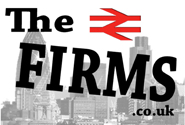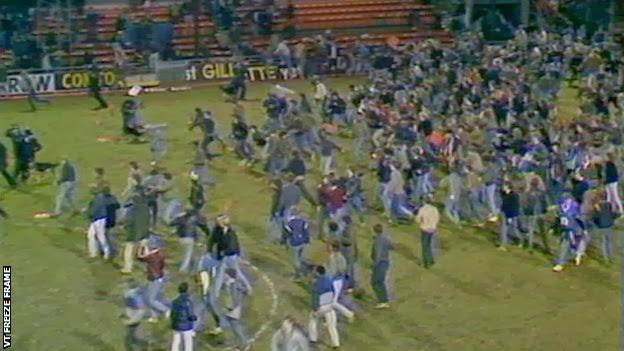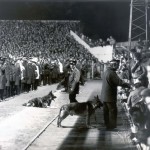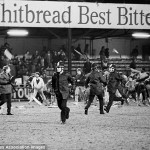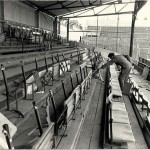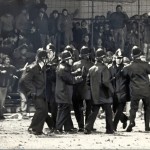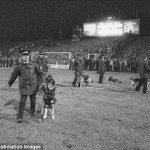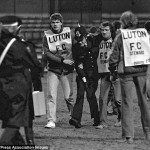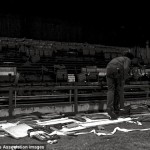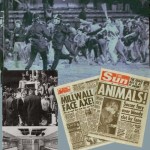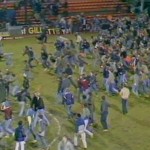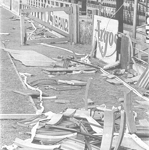Kenilworth Road Riot – Luton v Millwall 1985
Firms Involved Millwall and Luton
The 1985 Kenilworth Road riot occurred before, during and after an FA Cup sixth-round football match between Luton Town and Millwall on 13 March 1985 at Luton Town’s Kenilworth Road ground. It was one of the worst incidents of football hooliganism during the 1980s, and led to a ban on away supporters by Luton Town which lasted for four seasons. This itself led to Luton’s expulsion from the Football League Cup during the 1986–87season. The club also began to enforce a membership card scheme, which Margaret Thatcher’s government attempted to have adopted at grounds across England. Kenilworth Road was damaged, along with the surrounding area, and a year later was converted to an all-seater stadium.
Millwall’s unwanted association with football hooliganism became strongly apparent with their rise in the English game during the 1980s. Millwall’s Bushwackers were already one of the most notorious hooligan firms in the country by 1985, while Luton Town had their own fringe of hooligans in the MIGs. The Den, home of Millwall, had been the scene of a riot seven years earlier, when during another FA Cup sixth-round match against Ipswich Town Millwall-aligned hooligans had injured dozens of their own club’s supporters. Following the incident, the opinion of Ipswich manager Bobby Robson was that “[the police] should have turned the flamethrowers on them”.
When George Graham had been appointed manager halfway through the 1982–83 season, Millwall had been bottom of the then third-tier Third Division and battling relegation to the Fourth Division; however, by the time of this FA Cup sixth-round match at First Division Luton Town’s Kenilworth
Road ground on 13 March 1985, they were challenging for promotion to the second tier. Luton had beaten their arch-rivals Watford in the previous round without incident, while Millwall had upset the odds with a 2–0 home victory over top-flight Leicester City. On the day of the match, Luton were second from bottom of the top division, while Millwall were third in the third tier.
Although Luton were asked by Millwall to make the Wednesday night match all-ticket, the warning was not heeded. A disproportionately large away following, twice the size of Millwall’s average home gate, arrived on the day of the game, and by 5.00 pm pubs and newsagents around the town were having windows smashed as the police struggled to cope. The Kenilworth Stand, at that time still a vast terrace, was reserved for the away supporters that night. It was overflowing by 7.00 pm – 45 minutes before kick-off – with spectators even perched on the scoreboard supports after the turnstiles had been broken down. Ten minutes later, the police were helpless as hundreds of the visitors scaled the fences in front of the stand to rush down the pitch towards Luton’s supporters in the packed Oak Road End. A hail of bottles, cans, nails and coins saw the home supporters fleeing up the terraces, but their numbers, still growing as fans entered the stand, meant that there was little they could do to avoid the missiles.
The players came out to warm up, and almost immediately vanished back up the tunnel. The rioters then set upon the Bobbers Stand, ripping out seats and brandishing them as weapons. A message appeared on the stadium’s electronic scoreboard, stating that the match would not start until they returned to their allocated area, but this was ignored; an appeal from Millwall manager George Graham over the ground’s loudspeaker also had no effect. It was only when Graham appeared on the sideline that the spectators finally returned to the Kenilworth Stand. Even after this some managed to find their way into the Main Stand, where isolated fights broke out and more seats were removed. The arrival of police dogs helped to clear the pitch; the match began on time, with many watching from atop the Bobbers Stand after climbing the floodlight pylons.
Following the final whistle, and a 1–0 victory for Luton, the visiting fans invaded the pitch. Both Luton and Millwall players sprinted for the dressing room as fast as they could – one hooligan rushed towards Luton coach Trevor Hartley, and tried to grab him, but Hartley managed to wriggle free and race towards the tunnel after the players. The hooligans made for the Bobbers Stand once more, and started to tear seats out as the fences at the front of the stand were forced down. The seats ripped from the stand were hurled onto the pitch towards the police, who started to fall back, before regrouping and charging in waves, batons drawn. Gradually, the police started to win the battle – the hooligans then started to take seats from the Main Stand and throw them like “makeshift plastic spears”. The police were not without casualties – of the 81 people injured, 31 were policemen. Sergeant Colin Cooke was caught in the centre circle and stricken on the head with a concrete block. He stopped breathing, but PC Phil Evans resuscitated him while being punched, kicked and hit himself by the concrete.
The carnage continued through the town, as a battle between the mob and the police developed, leaving smashed cars, shops and homes in its wake. When the situation was brought back under control, 31 men were arrested and taken to Luton Magistrates’ Court the following morning. The majority of the 31 identified themselves as supporters of teams other than Millwall, most notably Chelsea and West Ham United.
Gallery
